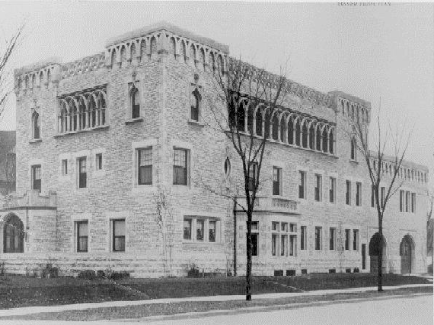About

1909 |

2013 |
Address: 2445 Park Avenue
Neighborhood: Phillips West
Construction Date: 1907
Contractor: Charles F. Haglin
Architect: Franklin B. Long and Louis Long
Architectural Style: Venetian Gothic
Historic Use: Residence
Current Use: Office
Date of Local Designation: 2015
Date of National Register Designation: N/A
Area(s) of Significance: Architecture; Neighborhood Development; Master Architect; Significant Persons
Period of Significance: 1907-1940
Historic Profile: The Anson Brooks Mansion, constructed in 1907 for lumber baron Anson Strong Brooks and family, is the only known example of Venetian Gothic architecture in Minnesota. The Venetian Gothic style originated in 14th Century Venice with the confluence of Byzantine styles from Constantinople, Arab influences from Moorish Span, and early Gothic forms from mainland Italy.
Park Avenue between Franklin Avenue and East 28th Street in the era of Anson Brooks was known as Minneapolis’ “Golden Mile.” The Brooks Mansion was one of 35 architect-designed homes built for several of the City’s wealthiest and most prominent businessmen and civic leaders. By the 1920s the wealthy residents of Park Avenue had begun to move to other, less busy, areas of the city. Many of their former homes came to house commercial and non-profit organizations and over the years the majority of homes along Park Avenue were demolished. The Brooks Mansion is one of only eight that remain today.
The Brooks Mansion is also historically significant for Anson Brooks and members of his family. Anson Strong Brooks made his fortune in both the grain and lumber milling industries. In 1896, Anson Brooks and two of his brothers, Dwight and Lester, started the Brooks Brothers Milling Company. In 1901 they partnered with M. J. Scanlon and Henry E. Gipson and by 1903, Brooks-Scanlon had become the largest lumber sawmilling operation in the Northwest.
Brooks was also prominent in a number of civic organizations, most notably the Chamber of Commerce. He was one of a number of prominent citizens who arranged to have the Father of Waters sculpture brought from Italy to Minneapolis where it is prominently displayed in the rotunda of Minneapolis City Hall.
Finally, the Brooks Mansion is significant because of its association with architects Franklin and Louis Long. A catalog of their commissions—both during their partnership and in association with other partnerships, namely Long and Kees—represent a variety of architectural and building types. Based on previous locally and nationally designated works, Franklin Long is recognized as one of Minneapolis’ premiere architects and would be considered a master architect. Louis’s catalogue, while not as extensive as his father’s, is also impressive and could qualify him for master architect status, as well. The Anson S. Brooks Mansion conveys the original design intent of Long & Long, with virtually no exterior or interior modifications to the building’s original design.
Photo Credits:
1909 – Western Architect
2013 - Spacecrafting
Works Cited:
“Anson Brooks Mansion Designation Study,” 2015.

